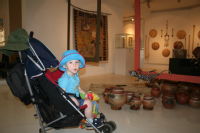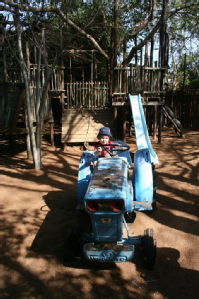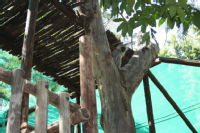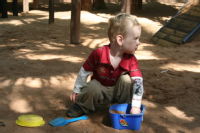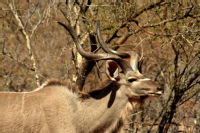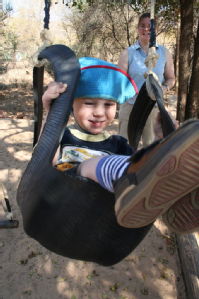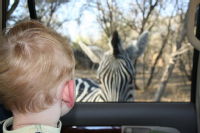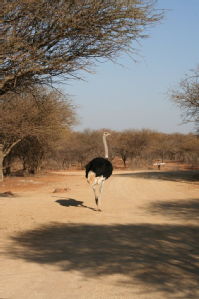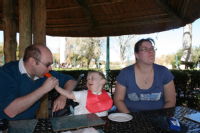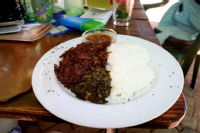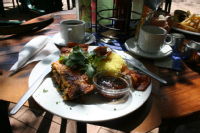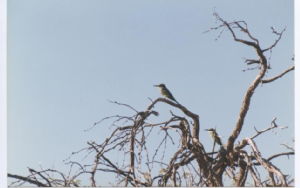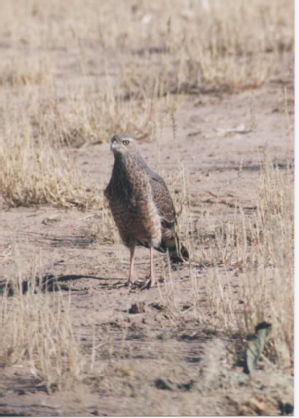All 8 entries tagged Botswana
View all 9 entries tagged Botswana on Warwick Blogs | View entries tagged Botswana at Technorati | View all 13 images tagged Botswana
March 19, 2009
No.1 Ladies' Opera House restaurant, Gaborone, Botswana
Follow-up to Botswana – yes, it really is quite like McCall Smith, Minghella and Curtis say it is from Transversality - Robert O'Toole
Lovely place. Out past Kgale Sidings, cows roaming around the street un-herded. If you're ever in Gabs and have a spare afternoon, try the seswaa pancakes - but watch out for bones! It's a really great dish, a unique flavour. I'm told that it's impossible to make outside of the Kalahari. Something to do with herbs that grow nowhere else in the world.

Lawrence loved playing in the cattle-trough turned water-feature...

And Mma Emma sat in the shade looking like a no.1 lady...

I'm told that they also sometimes do opera!
Botswana – yes, it really is quite like McCall Smith, Minghella and Curtis say it is
"Rose tinted view of Africa." - Kirsty Lang, Front Row today - SAID IT AGAIN!
Every review or article about the No.1 Ladies' Detective Agency TV shows expresses that same prejudice. "Surely Africa isn't like that". Richard Curtis tried his best to correct the misapprehension. He mentioned Comic Relief, and how some of the images of Africa that it portrayed may have left a lasting impression of the continent being all poverty and disease. Perhaps his work on the Lady Detective series will help us to forget those pictures.
But only if we can get this message across: Botswana really is a good, friendly, warm, cheerful place. And much of the rest of Africa is too.

Click image to enlarge
Lawrence playing detectives outside of the No. 1 Ladies Opera House, Gaborone
I've been visiting Gaborone every year since 1993. My wife grew up there. We were both amazed at how precisely the TV films represents Botswana and the Batswana (so far as TV can accurately represent anything). The detail is quite extraordinary - pictures on the wall that you would only ever see in Botswana, furniture, cars, buildings, the way in which people talk to each other, their facial expressions, the gay hairdresser - IN MY EXPERIENCE ALL MALE HAIRDRESSERS IN BOTSWANA ARE GAY! - or at least they pretend to be - the one's that I've met. And that's no problem, it's a tollerant and peaceful country.
Yes, it is true true that the films focus on certain areas and aspects of Gaborone life. But we aren't really interested in seeing the traffic jams on the Tlokweng Road or the massive high-tech shopping malls that have mushroomed in the last few years. But no TV film ever pretends to represent a whole country in one go.
MCall Smith, Minghella, Curtis - ke itumetse borra!
December 07, 2008
Don't Run, Whatever You Do by Peter Allison
- Title:
- Rating:

The Okavango Delta, Botswana: africa's last great pristine wetland; final sanctuary of the persecuted African Wild Dog; dry-season saviour of one of the last surviving free-ranging elephant populations (over 80,000 of them).
And africa's most expensive tourist destination.
Low-volume, high cost is the rule, interpreted as luxury camping and champagne bush picnics by the handfull of safari companies good enough to win a concession from the local people. It's not a national park. The Delta remains largley in the hands of the local communities, some of whom still live there, and many of whom work in the scattering of camps that dot the wetlands from the pan-handle in the north, through the Moremi Tongue, Dead Tree Island and Chief's Island, and down towards Maun. Amongst them are some of the best safari guides in Africa. People who have lived the entire lives in the Delta. They have an impressive knowledge of nature. Most speak several languages, African and European.
For an outsider to succeed in that game is quite impressive. For one even to survive, where unlike in other countries safaris are commonly on foot and un-armed, is slightly miraculous. And to do so with great humour and friendliness - brilliant.
Peter Allison did just that, eventually becoming manager of a luxury camp. His account of those years gives a fascinating insight into the business, its difficulties and many, many strange events. I've heard anecdotes along these lines before, sit at the bar at Nata Lodge for any length of time and you'll find them hard to escape. But Peter goes well beyond that, with humour and with a great understanding of ecology and tourism. Ultimately, this behind the scenes look might leave you feeling a little bit bemused by the safari business and its customers. The Okavango certainly is a unique place populated by some rather unusual animals. I've never quite felt comfortable there myself - far too fancy!
Here's a few photos that give an idea of what it's like...
Press the play button on the bottom right of the slide show.
October 06, 2007
Five good places to visit in Gaborone, Botswana
Follow-up to Botswana's finest chefs from Transversality - Robert O'Toole
Update: there’s a great new place in town – the No.1 Ladies’ Opera House.
1. The National Museum and Gallery
The museum has recently been renovated with many imaginative displays that illustrate the history, culture, geography and wildlife of Botswana. Highly realistic models and reconstructions are used. Traditional lifestyles are depicted with lifelike models of people (this really got Lawrence confused). Best of all are the models of animals and their habitats. An excellent way to learn.

Lawrence and the lions display (click to enlarge)

Looking at a reconstructed village scene
The museum also houses a gallery, used for displaying the best of current craft works from around the country (many for sale). There are ingenious sculptures, fine basket works, clothing, and much more. Another room hosts temporary exhibitions. In August 07 we saw some great paintings of anachronistic scenes from Botswana life, such as rondavels with satellite dishes.
2. Sanitas Garden Centre and restaurant
See the magic work of horticulturalist Dr. Gus Nilsson and his team of gardeners. Visit the best restaurant in Botswana. Chase the cheeky vervet monkey around the big wooden adventure playground as part of a big group of semi-wild african children. What more could you ask for? Sanitas is Gaborone’s best outdoors attraction. Visitors to Gaborone will probably not want to buy plants, but the displays are interesting in themselves. Use the garden centre as an opportunity to become familiar with the indigeneous flora and its preferred conditions. You may want to buy some of the garden ornaments on sale, such as metal animal and bird sculptures.

A useful coding system is used in the garden
3. Mokolodi Nature Reserve
Mokolodi is about ten minutes drive from Gaborone, along the Lobatse Road. It is a small nature reserve, with largely educational intentions. Non-members can tour the park on an official game drive. Other activities include meeting the orphan cheetahs, rhino tracking, bush picnics, and horse riding. Members can drive around on their own.

My family and other rhinoceroses

Poking a pile of rhino dung with a stick

Drought: normally this would be a lake not a pond

Drought: even the warthogs are being artificially fed
4. Gaborone Game Reserve
600 hectares of land right inside the city. Gaborone Game Reserve offers a chance to see some of the animals typical of the kalahari. Perhaps more significant is the bird life attracted to the large and smelly sewerage ponds that are part of the reserve. Spectacular sightings are certain. Even flamingoes and pelicans are possible.

Lawrence hiding from rapidly approaching zebra
The zebras in the park have an awkward habit: they will put their heads through an open car window in search of food. I once had one chewing the steering wheel. This time I got the window closed in time. Lawrence was amused to watch it licking the window.

Ostrich burying its head to avoid the smell
5. Garden of the Grand Palms Hotel
Eat nice food. Drink underneath shady trees. Watch water birds in the small lake. Swim in the hotel pool. There’s even a children’s play area.
October 02, 2007
Botswana's finest chefs
Follow-up to My Family and Other Primates, Kruger Park 2007 Part 6 from Transversality - Robert O'Toole
“Dullstroom” – what a great name for a dorp in the middle of knowhere. I suspect that it is actually a little misleading. I bet there’s excitement if not intrigue to be found along its dusty dry streets. Well at least the fishermen are happy, the game fish growing large in the fresh and lively waters of the area. Several monster specimens are displayed around the bar, preserved in cases. A smaller but much more edible individual was served up on my plate. Possibly the best wild trout that i have eaten.
A comfortable night’s rest was had in an apartment at the Courtyard Hotel in the Arcadia district of Pretoria/Tshwane, followed by a short drive through the Magalisberg Mountains, across the Marico, and home to Gaborone, Botswana.

And the goat is served (ckick to enlarge)
And what of Botswana? Somehow it has acquired a reputation for dull food. Our friends Peter and Johanna are working hard to disprove that claim. The kalahari being goat country, they prepared and cooked a fat juicy leg, marinated in garlic. Fantastic! When slaughtering their own goat, they discovered an extraordinary world of beaurocracy, so now they prefer to buy their meat at JT Butcheries. No matter, it was perfect. Goat is a fine meat, with more depth to its flavour than all but the finest lamb. And yet even in Botswana it is known through the euphemism of “mutton”. At the Taj Indian restaurant, for example, many great goat curries (not curried goat) are served, amongst their other nice dishes.
More evidence of great cooking in Botswana may be found at the Sanitas Garden Centre near to Gaborone Dam. Seswaa, the classic dish of the Batswana, is often on the menu. It is a tasty dish, but hard work to make. Essentially a cow, pounded and smashed to smitherenes, it is slowly cooked to a dry and stringy result, with plenty of fragments of bone and attendant marrow. Alongside the pulverised bovine, one traditionally recieves a good helping of mealie pap (polenta), gravy, and a concoction of green vegetables called ‘morogo’. Spinach seems to be part of the mix, however I’m also told that various kalahari grown wild herbs are essential exotic requirements.
Another southern African classic from Sanitas, bobotie and rice. Minced beef, with a combination of fruit, curry and pepper typical of Karoo cooking, and topped with an egg mix. Again excellent.
A further recommendation: the patio of the Grand Palms Hotel, next to its lake, swimming pool, and play area, serves good home made burgers and salads.
Botswana then is a place for good food. Yes, there are many second or third rate restaurants springing up amongst the brash new shopping malls. And yes, Motswana are adicted to badly fried chicken. But if you know where to look, there are some world class gems.
October 18, 2005
Travel Report: Bike expedition to the Kalahari booked
Writing about web page http://www.karoo-biking.de/en/index.php
I shall fly to Cape Town and hire one of these from Karoo Biking:

from the official BMW GS web site
…that is a BMW F650GS Dakar, a smaller and lighter Gelandestrasse than my R100GS Dakar, but just as capable an off-road tourer (it has won the Paris-Dakar rally twice). Tank range might be a problem, I guess that it will do about 300km's between fills, so I may need to carry a small plastic can. I've got some lightweight camping gear, which I will carry in a Gelert dry bag bungeed to the seat and rack.
And then i'll head north through the Karoo, the arid plateau in the centre of South Africa. I have travelled a similar route before. From the cold Atlantic coast, the amazing long climb over the Swartberg. Flamingoes in the salt pans between Calvinia and Kenhardt. Northwards into the absolute desert of the south-west Kalahari…

a photo I took last time I went to the SW Kalahari
It's been far too long since I was last in a desert (a trip to the Moroccan Sahara being the last). I miss it so much. I'm planning to head up to Pofadder, and then take some of the dirt roads to the west. Looking at the 1:25,000 South African government geographical map that I have, I can see some fascinating terrain – including dunes. And looking at the satellite images on Google Earth, I can even see some of these features in 3-d:

from the Google Earth satellite maps application
The small communities between Pofadder and the Richtersveld (an empty rocky desert area on the border with Namibia) are initiating "community tourism" projects, with camp sites and small nature reserves. If possible I will investigate these. I will then head west to the coast. I'm not yet sure where i'll hit the coast, perhaps as far north as the mouth of the Gariep (Orange) River. I will definitely revisit the gannet and penguin colonies at Lambert's Bay, looking for whales along the coast.
And then back to Cape Town, possibly visiting some of the national parks along the Cape coast.
Once I have returned the bike, i'll fly up to Gaborone, Botswana for a couple of weeks with Emma and Lawrence.
October 11, 2005
Travel Report: Kgalagadi (Gemsbok) Transfrontier Park, SA/Botswana
Writing about web page http://www.sanparks.org/parks/kgalagadi/

The Kalahari Gemsbok Park in South Africa, which has now become the Kgalagadi Transfrontier Park with its merger with the Gemsbok Park in Botswana across the border, is my favourite of the southern African wildlife reserves. It combines four of my top priorities: full desert with dune fields, big game, raptors, and a diversity of small but fascinating mammals.
After a long drive from Botswana, including a stop in Hotazel (pronounced Hot-as-hell, which is exactly what it is), as we neared the park the dunes began: red, sweeping, burning dunes – not as large as those of Merzouga in the Sahara, but all the same quite sublime. If you have never been to a desert dune-field, imagine yourself at the seaside, but with no sea, no water, no civilisation anywhere to be seen.
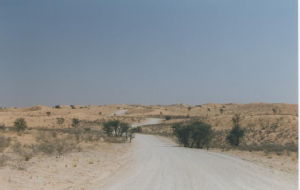 | 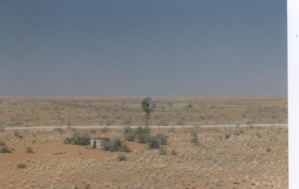 |
Dirt road through the dune fields. | A wind pump in the desolate Kalahari. |
But there is life. First of all, the tsama melon with its deep tap root accessing hidden water and swelling into a fruit:

These, and other such drought-defying flora, provides sustainance to an amazing variety of fauna, such as these dune-dwelling ostriches:

A food chain that even extends to the most powerful and hungry of predators:
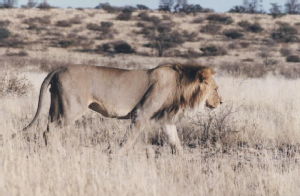 |  |
Our first drive out into the park gave us a dramatic view of these predator-prey interactions:
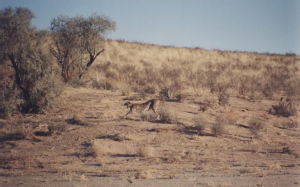 | 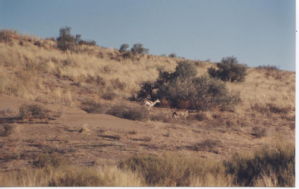 |
A hungry cheetah. | A meal wanders over the brow of a dune. |
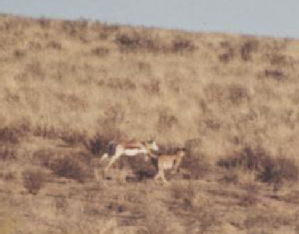 | 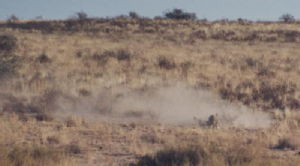 |
High speed chase between cheetah and springbok. | The springbok is tripped and the killer engages the prey. |
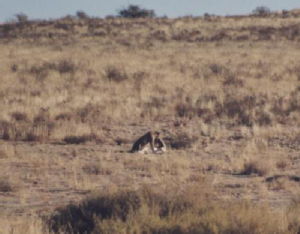 | 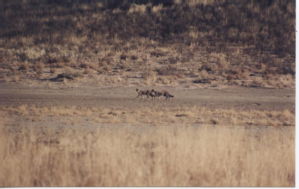 |
In an instant the springbok is converted into a meal. | Not cruelty but necessity, as the cheetah's young join its mother. |
But it's not all brutal drama in the sands. A wealth of smaller but equally beautiful creatures can be found, including some superb small carnivores:
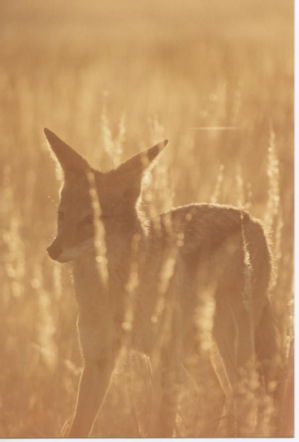 | 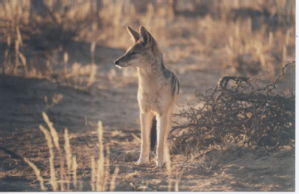 |
Side-striped jackal in the morning desert light. | Jackal portrait. |

A group of african wildcats, they actually behaved very much like domestic cats, and at one point walked under our Hilux.

The insectivorous bat-eared fox.
The birdlife is also surprisingly prolific:

A kori bustard.
We experienced many close-encounters with raptors:

Pale-chanting goshawk with a kill.
After several nights spent in the park, staying at the good National Parks huts at Nossob and Mata Mata, we left the desert with some great memories, not the least of which was of the gemsbok antelope after which the park is named, to be found deep in the dunes, looking quite majestic:
August 08, 2004
Mma Ramotswe And The Full Shopping Bag of Despair
“Dumela Mma”, said Mr J.L.B. Matekoni, proprietor of Tlokweng Road Speedy Motors. Mma Ramotswe slowly turned around in response, replying to his call with a monetarily cheerfull “Dumela Raa”, only to resume once again her sombre appraisal of the crime scene.
Mr J.L.B. Maketoni looked around in confusion. What was it that was making this erudite lady detective just so sad? At first he could see nothing unusual. As always the streets of Gaborone were filled with happy people busily making their lunchtime ways to or from Pie City, KFC, Nandos or some other such culinary establishment. Children played in the dust, baboons made exploratory forays into the city limits just a short distance down the Lobatse Road, whilst fat Nguni cattle pondered their chances of surviving the murderous traffic in hope of better grazing on the other side of the highway.

Cows crossing the Lobatse Road
Suddenly she turned around to face her motor mechanical friend, lifting her arms up and sweeping them around in a most dramatic expression towards Kgale Hill. “Such a crime!, this is so terrible”. Kgale, with its familiar ‘sleeping giant’ face, stared indigantly back. To Mma Ramotswe’s increasing annoyance, Mr J.L.B. Maketoni could still not understand just what the problem was. He could identify a worn camshaft from just the sound of an idling engine, but in this case his powers of perception were failing him.
“Just look, she said, look at Kgale View! What can you see?”. Mr J.L.B. Maketoni looked towards the foot of Kgale Hill, the headquarters of the Lady Detective Agency.

The new view of Kgale Hill
And then it all became apparent. Mma Ramotswe had just spent some time away from Botswana. Having been a keynote speaker at the great international conference of lady detectives in the USA, and having spent some unplanned time there solving various mysteries that were beyond her American guests (one of which involved a President and a young lady), quite clearly she was taken by surprise when encountering recent developments. Her tiny office was dwarfed by newly constructed grey and entirely out of place office blocks. Her view of the magical mountain, such a great source of inspiration, now permanently blocked. No longer could she watch the changing colours through the day, bateleur eagles dancing around its summit, and the occasional tourist heaving their way breathlessly to a magnificent view from the top.
Mma Ramotswe was close to tears. But there was worse still. Not only had her view been spoilt, but also the path to the little shopping centre that she so enjoyed walking along had been blocked by a terrible monster. The biggest indoor shopping mall in Africa had landed right outside her front door. She remembered her childhood, she remembered how proud everyone was of the country’s first mall, and how anyone could enjoy its open air splendour.

The old shopping mall
Mma Ramotswe had seen many terible things during her visit to the USA. Murders, corruption, Jerry Springer. But worst of all was the kind of progress that brought the ubiqitous indoor shopping mall to every small town. Progress, she thought, can just be so backwards.
And then Mr. J.L.B. Maketoni had an idea, a great idea worthy of the Lady Detective herself. “Come with me” he said. And off they went to the Tlokweng Road. At first Mma Ramotswe thought he was taking her back to his workshop for yet another meal of cold chips and tea (with 5 sugers). But at the last moment he changed direction, heading for somewhere also quite new. They parked amongst the Mercedes and Landcruisers, walked a short distance, sat down at a beutiful new coffee shop in the open air, watching the children play by the ice cream stand.

The new River Walk mall on the Tlokweng Road
Mr. J.L.B. Maketoni then did something that quite amazed Mma Ramotswe. Down he went onto one knee and said: “Mma, i know i do not have many cattle for the Bogodi, and i know that i am not a cultured man, but i would still like to ask you for the greatest gift, that of mariage.”
Mma Ramotswe said in reply “sometimes progress isn’t such a bad thing”.
 Robert O'Toole
Robert O'Toole

 Please wait - comments are loading
Please wait - comments are loading

